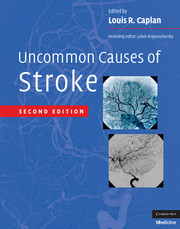Book contents
- Uncommon Causes of Stroke
- Uncommon Causes of Stroke
- Copyright page
- Contents
- List of Contributors
- Preface
- PART I: INFECTIOUS AND INFLAMMATORY CONDITIONS
- 1 ISOLATED ANGIITIS OF THE CENTRAL NERVOUS SYSTEM
- 2 TEMPORAL ARTERITIS
- 3 VARICELLA ZOSTER AND OTHER VIRUS-RELATED CEREBRAL VASCULOPATHY
- 4 TAKAYASU DISEASE
- 5 BÜRGER’S DISEASE (THROMBOANGIITIS OBLITERANS)
- 6 NEUROSYPHILIS AND STROKE
- 7 VASCULITIS AND STROKE DUE TO TUBERCULOSIS
- 8 STROKE DUE TO FUNGAL INFECTIONS
- 9 STROKE AND VASCULITIS IN PATIENTS WITH CYSTICERCOSIS
- 10 STROKE IN PATIENTS WITH LYME DISEASE
- 11 BEHÇET’S DISEASE
- 12 STROKE AND NEUROSARCOIDOSIS
- 13 KAWASAKI DISEASE: CEREBROVASCULAR AND NEUROLOGIC COMPLICATIONS
- 14 CEREBROVASCULAR PROBLEMS IN CHAGAS’ DISEASE
- 15 STROKE IN PERSONS INFECTED WITH HIV
- PART II: HEREDITARY AND GENETIC CONDITIONS AND MALFORMATIONS
- PART III: VASCULAR CONDITIONS OF THE EYES, EARS, AND BRAIN
- PART IV: DISORDERS INVOLVING ABNORMAL COAGULATION
- PART V: SYSTEMIC DISORDERS THAT ALSO INVOLVE THE CEREBROVASCULAR SYSTEM
- PART VI: NONINFLAMMATORY DISORDERS OF THE ARTERIAL WALL
- PART VII: VENOUS OCCLUSIVE CONDITIONS
- PART VIII: VASOSPASTIC CONDITIONS AND OTHER MISCELLANEOUS VASCULOPATHIES
- PART IX: OTHER MISCELLANEOUS CONDITIONS
- Index
11 - BEHÇET’S DISEASE
from PART I: - INFECTIOUS AND INFLAMMATORY CONDITIONS
Published online by Cambridge University Press: 06 January 2010
- Uncommon Causes of Stroke
- Uncommon Causes of Stroke
- Copyright page
- Contents
- List of Contributors
- Preface
- PART I: INFECTIOUS AND INFLAMMATORY CONDITIONS
- 1 ISOLATED ANGIITIS OF THE CENTRAL NERVOUS SYSTEM
- 2 TEMPORAL ARTERITIS
- 3 VARICELLA ZOSTER AND OTHER VIRUS-RELATED CEREBRAL VASCULOPATHY
- 4 TAKAYASU DISEASE
- 5 BÜRGER’S DISEASE (THROMBOANGIITIS OBLITERANS)
- 6 NEUROSYPHILIS AND STROKE
- 7 VASCULITIS AND STROKE DUE TO TUBERCULOSIS
- 8 STROKE DUE TO FUNGAL INFECTIONS
- 9 STROKE AND VASCULITIS IN PATIENTS WITH CYSTICERCOSIS
- 10 STROKE IN PATIENTS WITH LYME DISEASE
- 11 BEHÇET’S DISEASE
- 12 STROKE AND NEUROSARCOIDOSIS
- 13 KAWASAKI DISEASE: CEREBROVASCULAR AND NEUROLOGIC COMPLICATIONS
- 14 CEREBROVASCULAR PROBLEMS IN CHAGAS’ DISEASE
- 15 STROKE IN PERSONS INFECTED WITH HIV
- PART II: HEREDITARY AND GENETIC CONDITIONS AND MALFORMATIONS
- PART III: VASCULAR CONDITIONS OF THE EYES, EARS, AND BRAIN
- PART IV: DISORDERS INVOLVING ABNORMAL COAGULATION
- PART V: SYSTEMIC DISORDERS THAT ALSO INVOLVE THE CEREBROVASCULAR SYSTEM
- PART VI: NONINFLAMMATORY DISORDERS OF THE ARTERIAL WALL
- PART VII: VENOUS OCCLUSIVE CONDITIONS
- PART VIII: VASOSPASTIC CONDITIONS AND OTHER MISCELLANEOUS VASCULOPATHIES
- PART IX: OTHER MISCELLANEOUS CONDITIONS
- Index
Summary
- Type
- Chapter
- Information
- Uncommon Causes of Stroke , pp. 67 - 74Publisher: Cambridge University PressPrint publication year: 2008
- 3
- Cited by



